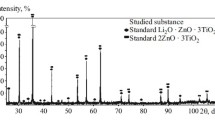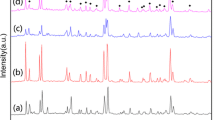The effect of the eutectic additive of the system Li2O–B2O3 on the sintering process and the dielectric properties of Li2MgTi3O8-based ceramics was studied. It was found that the introduction of an additive in amounts 10.0 – 15.0% promotes sintering of ceramics by means of a liquid-phase mechanism. Li2MgTi3O8-based ceramic, containing a sintering additive in the amount 15.0% and fired at 900°C, demonstrates the following property levels: average density ρav = 3.04 g/cm3, open porosity Po = 5.7%, relative dielectric constant εr = 19.0, and dielectric loss tangent tan δ = 0.028. The lowered sintering temperature of the ceramic will allow the manufacture of different electronic components based on it, using low-temperature co-firing ceramic (LTCC) technology, and the a specified level of dielectric properties will allow the miniaturization of devices.







Similar content being viewed by others
References
A. Sasaki and Y. Shimada, “Electrical design technology for low dielectric constant multilayer ceramic substrate,” IEEE on Components, 15(1), 56 – 62 (1992).
M. T. Sebastian, Dielectric Materials for Wireless Communication, Elsevier Science, Amsterdam, Netherlands (2008).
D. S. Voloshchuk, V. V. Anisimov, and N. A. Makarov, “Ceramic materials based on Al2O3 for LTCC technology,” Glass Ceram., 79(11 – 12), 497 – 501 (2022).
X. Chen, H. Zhou, L. Fand, et al. “Microwave dielectric properties and its compatibility with silver electrode of Li2MgTi3O8 multichip,” J. of Physics, No. 19, 5829 – 5832 (2005).
V. T. Zaspalis, M. Kolenbrander, J. Boerekamp, et al., “Materials for inductive and microwave function integration in LTCC-technology multichip modules,” J. of Physics, No. 10, 357 – 360 (2005).
F. Ya. Galakhov, State Diagrams of Refractory Oxide Systems: a Reference Book [in Russian], Nauka, Leningrad Branch, Leningrad (1985).
Author information
Authors and Affiliations
Corresponding author
Additional information
Translated from Steklo i Keramika, No. 11, pp. 3 – 9, November, 2023.
Rights and permissions
Springer Nature or its licensor (e.g. a society or other partner) holds exclusive rights to this article under a publishing agreement with the author(s) or other rightsholder(s); author self-archiving of the accepted manuscript version of this article is solely governed by the terms of such publishing agreement and applicable law.
About this article
Cite this article
Stolyarov, V.D., Shubabko, O.E. & Vershinin, D.I. Eutectic Additive Influence in the Li2O–B2O3 System on the Sintering Process and Properties of Li2MgTi3O8 Ceramics. Glass Ceram (2024). https://doi.org/10.1007/s10717-024-00633-w
Received:
Published:
DOI: https://doi.org/10.1007/s10717-024-00633-w




